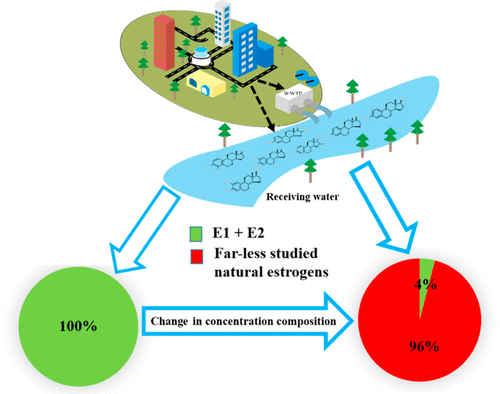当前位置:
X-MOL 学术
›
ACS ES&T Water
›
论文详情
Our official English website, www.x-mol.net, welcomes your feedback! (Note: you will need to create a separate account there.)
Far-Less Studied Natural Estrogens as Ignored Emerging Contaminants in Surface Water: Insights from Their Occurrence in the Pearl River, South China
ACS ES&T Water Pub Date : 2021-07-20 , DOI: 10.1021/acsestwater.1c00109 Zhao Tang 1 , Ze-hua Liu 1, 2, 3 , Yi-ping Wan 1 , Hao Wang 1 , Zhi Dang 1 , Yu Liu 4
ACS ES&T Water Pub Date : 2021-07-20 , DOI: 10.1021/acsestwater.1c00109 Zhao Tang 1 , Ze-hua Liu 1, 2, 3 , Yi-ping Wan 1 , Hao Wang 1 , Zhi Dang 1 , Yu Liu 4
Affiliation

|
Compared to the well-studied major natural estrogens [i.e., estrone (E1), 17β-estradiol (E2), and estriol (E3)], little information is currently available for far-less studied natural estrogens such as 2-hydroxyestrone (2OHE1), 4-hydroxyestrone (4OHE1), 16α-hydroxyestrone (16α-OHE1), 2-hydroxyestradiol (2OHE2), 4-hydroxyestradiol (4OHE2), 17-epiestriol (17epiE3), 16-epiestriol (16epiE3), and 16-ketoestradiol (16ketoE2) in surface water. In this study, seven natural estrogens (E1, 2OHE1, 16α-OHE1, E2, 4OHE1, 2OHE2, and 17epiE3) were found in the water of the Pearl River, with detection frequencies of 96%, 80%, 60%, 40%, 28%, 12%, and 12%, respectively. The mean concentrations of the detected natural estrogens decreased in the following order: 2OHE1 (12.0 ng/L) > 16α-OHE1 (8.3 ng/L) > E1 (5.2 ng/L) > 4OHE1 (2.6 ng/L) > E2 (2.3 ng/L) > 2OHE2 (1.1 ng/L) > 17epiE3 (0.5 ng/L). In addition, the estrogen equivalence (EEQ) contribution ratios of the far-less studied natural estrogens ranged from 0% to 94%, of which EEQ ratios of 37.5% of the sampling sites exceeded 50%. What’s more, if only the three major natural estrogens are considered, the number of sample sites at high risk will be reduced from 13 to 1. This work clearly shows that the current water safety assessments, which are only based on well-known major estrogens, need to be re-examined and updated with care.
中文翻译:

很少研究天然雌激素作为地表水中新出现的污染物:从它们在华南珠江中的发生获得的见解
与经过充分研究的主要天然雌激素 [即雌酮 (E1)、17β-雌二醇 (E2) 和雌三醇 (E3)] 相比,目前关于研究甚少的天然雌激素如 2-羟基雌酮 (2OHE1) 的信息很少), 4-羟基雌酮 (4OHE1), 16α-羟基雌酮 (16α-OHE1), 2-羟基雌二醇 (2OHE2), 4-羟基雌二醇 (4OHE2), 17-表三醇 (17epiE3), 16-表三醇 (16-epi16-epiE3) (16ketoE2) 在地表水中。本研究在珠江水域中发现了7种天然雌激素(E1、2OHE1、16α-OHE1、E2、4OHE1、2OHE2和17epiE3),检测频率分别为96%、80%、60%、40% 、28%、12% 和 12%。检测到的天然雌激素的平均浓度按以下顺序降低:2OHE1 (12.0 ng/L) > 16α-OHE1 (8.3 ng/L) > E1 (5.2 ng/L) > 4OHE1 (2.6 ng/L) > E2 ( 2.3 纳克/升) > 2OHE2 (1.1 ng/L) > 17epiE3 (0.5 ng/L)。此外,研究较少的天然雌激素的雌激素当量(EEQ)贡献率从0%到94%不等,其中37.5%的采样点的EEQ比超过50%。更重要的是,如果只考虑三大天然雌激素,高风险样本点的数量将从13个减少到1个。 这项工作清楚地表明,目前的水安全评估仅基于众所周知的主要雌激素,需要仔细检查和更新。
更新日期:2021-08-13
中文翻译:

很少研究天然雌激素作为地表水中新出现的污染物:从它们在华南珠江中的发生获得的见解
与经过充分研究的主要天然雌激素 [即雌酮 (E1)、17β-雌二醇 (E2) 和雌三醇 (E3)] 相比,目前关于研究甚少的天然雌激素如 2-羟基雌酮 (2OHE1) 的信息很少), 4-羟基雌酮 (4OHE1), 16α-羟基雌酮 (16α-OHE1), 2-羟基雌二醇 (2OHE2), 4-羟基雌二醇 (4OHE2), 17-表三醇 (17epiE3), 16-表三醇 (16-epi16-epiE3) (16ketoE2) 在地表水中。本研究在珠江水域中发现了7种天然雌激素(E1、2OHE1、16α-OHE1、E2、4OHE1、2OHE2和17epiE3),检测频率分别为96%、80%、60%、40% 、28%、12% 和 12%。检测到的天然雌激素的平均浓度按以下顺序降低:2OHE1 (12.0 ng/L) > 16α-OHE1 (8.3 ng/L) > E1 (5.2 ng/L) > 4OHE1 (2.6 ng/L) > E2 ( 2.3 纳克/升) > 2OHE2 (1.1 ng/L) > 17epiE3 (0.5 ng/L)。此外,研究较少的天然雌激素的雌激素当量(EEQ)贡献率从0%到94%不等,其中37.5%的采样点的EEQ比超过50%。更重要的是,如果只考虑三大天然雌激素,高风险样本点的数量将从13个减少到1个。 这项工作清楚地表明,目前的水安全评估仅基于众所周知的主要雌激素,需要仔细检查和更新。



























 京公网安备 11010802027423号
京公网安备 11010802027423号